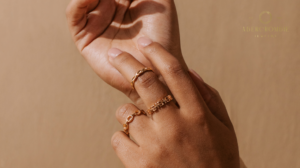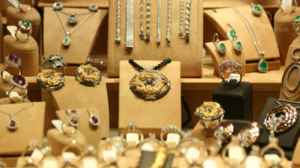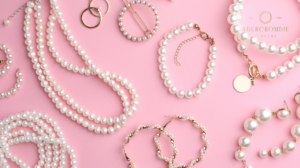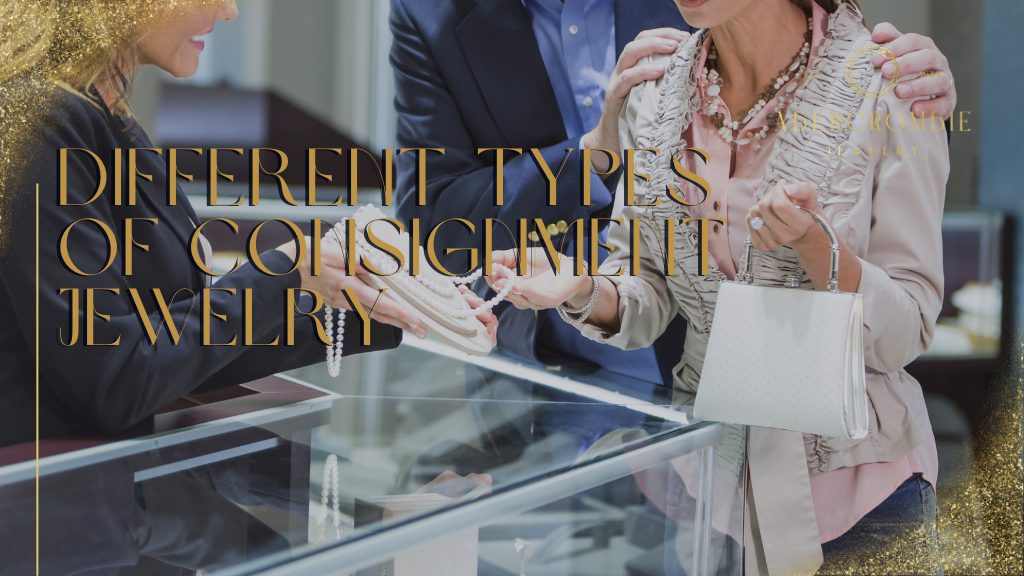Consignment jewelry offers a unique opportunity to own exquisite pieces with history and character that brand-new items often lack. But what is consignment jewelry? It’s a process where jewelry owners place their pieces in retail stores like Abercrombie Jewelry, allowing them to retain ownership until the item sells, with the retailer taking a percentage of the sale. This system benefits both parties, providing a platform for sellers and offering buyers diverse selections.
There are various types of consignment jewelry, each with its appeal. Vintage jewelry offers timeless beauty from past eras, allowing wearers to connect with history. Designer jewelry from luxury brands like Tiffany or Cartier brings prestige and exclusivity, while handmade or artisan pieces showcase individual craftsmanship and creativity. Consignment jewelry offers something for every taste, whether for elegance, uniqueness, or luxury.
At Abercrombie Jewelry, we specialize in curating an extensive range of consignment pieces, from vintage treasures to high-end designer finds. Whether you’re a collector or simply looking to add something special to your jewelry box, understanding the different types of consignment jewelry helps you make an informed choice, adding value and beauty to your collection.
What is consignment jewelry?
Consignment jewelry involves a unique arrangement where previously owned pieces are sold by a third party, usually a consignment shop or a specialized jewelry retailer. This process allows individuals to sell their jewelry, offering it a second chance to shine with a new owner. Unlike buying directly from brands or traditional retail stores, consignment provides access to various unique and often rare items at more approachable prices.
The foundation of this system is trust and expertise, as consignment stores take on the responsibility of evaluating, authenticating, and pricing these items. Factors such as the piece’s condition, brand, and current market demand play crucial roles in determining its value. This method supports a more sustainable fashion cycle by prolonging the life of jewelry. It creates a win-win scenario for sellers looking to recoup some value and buyers searching for distinctive, affordable options.
To illustrate, platforms like The RealReal, Vestiaire Collective, and eBay offer online consignment services, while physical stores such as Local Consignment Boutiques and Luxury Resale Shops provide in-person experiences. Online consignment shops often feature a wide range of items from around the globe, offering convenience and a broader selection. In contrast, physical stores allow customers to see, touch, and try on jewelry, offering a more tactile shopping experience.
Each type operates differently in logistics, pricing, and customer interaction, catering to various preferences and needs.





Why do people choose consignment jewelry?
Individuals gravitate towards consignment jewelry for a variety of meaningful reasons. One of the primary attractions is the opportunity to discover unique or vintage pieces that simply can’t be found in regular stores. This quest for uniqueness allows enthusiasts to acquire distinctive designs and craftsmanship that reflect different eras and styles, making each piece a conversation starter.
For instance, Jane Doe, a vintage jewelry collector, found a rare 1920s Art Deco necklace at a local consignment shop, a piece that had been on her wishlist for years. This find added immense value to her collection and showcased the potential treasures hidden within consignment stores. Another significant factor is the affordability of consignment jewelry compared to traditional retail prices.
The consignment model offers buyers the chance to own luxury and high-quality jewelry at a fraction of the cost, making it an attractive option for those who appreciate fine jewelry but are mindful of their budget. For example, John Smith purchased a designer Cartier watch at 60% off the retail price, demonstrating the financial advantages of choosing consignment. Lastly, selling jewelry on consignment appeals to individuals looking to declutter their collections or recoup some financial value from pieces they no longer use.
Emily Johnson, who sold several pieces of her handmade jewelry through a consignment shop, found it an effective way to reach a wider audience and sell her creations more quickly than she could have independently. This aspect is particularly appealing in today’s eco-conscious society, as it promotes a more sustainable approach to fashion by giving jewelry a second life. Whether driven by the desire for uniqueness, affordability, or sustainability, consignment jewelry presents a compelling choice for many enthusiasts.
What are the main types of consignment jewelry?
In the eclectic world of consignment jewelry, a few main types stand out, each offering something unique to enthusiasts and collectors. Vintage jewelry captures the essence of bygone eras, with pieces from the Art Deco or Victorian periods being particularly prized for their historical value and timeless elegance. Designer jewelry from iconic brands like Tiffany or Cartier brings a touch of luxury and exclusivity, known for its exceptional quality and enduring designs.
Handmade or artisan jewelry showcases the individual creativity and craftsmanship of local or lesser-known artists, offering one-of-a-kind pieces that are as unique as the wearers themselves. Each category of consignment jewelry adds diversity to one’s collection and tells a story, making each piece a conversation starter and a treasure to be cherished.
Vintage jewelry from specific eras, like Art Deco or Victorian
Vintage jewelry is a testament to the enduring allure of past eras, offering a tangible connection to the Art Deco and Victorian periods, among others. These pieces are celebrated for their historical significance and distinctive styles, ranging from the bold, geometric shapes of Art Deco to the delicate, ornate designs of the Victorian era. For example, a 1920s Art Deco necklace might feature intricate geometric patterns and be crafted from platinum and diamonds, embodying the luxury and innovation of the time.
Each vintage piece carries a story, making it a deeply personal and cherished addition to any jewelry collection.
Designer jewelry from high-end brands like Tiffany or Cartier
Designer jewelry from esteemed brands such as Tiffany and Cartier epitomizes luxury and unparalleled craftsmanship. These pieces are not just accessories but symbols of sophistication and timeless appeal. A classic example is the Cartier Love Bracelet, designed in the 1970s as a symbol of unending love; its unique locking mechanism can only be opened with a special screwdriver, adding to its allure.
Consignment offers a unique opportunity to acquire these high-end treasures at more accessible prices, allowing a broader audience to indulge in their beauty and elegance.
Handmade or artisan jewelry from local or unknown artists
Handmade or artisan jewelry stands out for its originality and the personal touch of its creators. Crafted by local or lesser-known artists, these pieces embody the spirit of creativity and individual expression. An example might be a hand-forged silver pendant inspired by natural landscapes and made by a local artisan, each mark and curve reflecting the artist’s vision and technique.
With an emphasis on unique designs and materials, handmade jewelry offers a special connection to the artisan’s vision and technique, making each piece a one-of-a-kind work of art.
How does consignment work for jewelry?
The consignment process for jewelry initiates a partnership between the original owner and the consignment shop. Owners submit their pieces to the shop, which then sells them. Key to this arrangement is the evaluation of each piece, where factors like condition, brand, and market demand come into play to set a fair selling price.
Upon agreement, the jewelry is showcased for sale. When a piece finds a new owner, the consignment shop retains a pre-agreed commission, and the rest of the sale proceeds go back to the original owner. This system benefits sellers by giving them a platform to sell their items, while buyers enjoy access to a varied jewelry collection at prices often lower than retail.
To provide a clearer expectation of the process, we’ve detailed typical commission rates and the average time it takes for jewelry to sell in a consignment shop in the table below:
| Factor | Description | Typical Range |
| Commission Rate | Percentage of the sale price retained by the consignment shop. | 25% – 50% |
| Average Sale Time | The typical duration from listing to sale. | 1 – 6 months |
| Condition Impact | How the condition of the jewelry affects its saleability. | Better condition = Quicker sale |
| Brand Influence | The effect of the jewelry’s brand on its desirability and sale time. | High-end brands (e.g., Tiffany, Cartier) often sell faster |
| Market Demand | Current trends and collector interest affect sale time. | High-demand items sell quicker |
The consignment process: Owners provide jewelry to shops, which sell it for a commission
At the heart of the consignment process is a partnership where jewelry owners entrust their pieces to consignment shops. This arrangement hinges on the shop’s ability to sell the jewelry on behalf of the owner. Once a sale is made, the shop recurs a commission for its selling efforts, and the original owner receives the balance.
This collaborative approach benefits owners by leveraging the shop’s expertise and customer base to find buyers, often leading to more successful sales outcomes.
Pricing consignment jewelry: Based on condition, brand, and market demand
Pricing consignment jewelry is a nuanced process that takes into account the condition of the item, the brand it represents, and the current market demand. Items in pristine condition are more valuable, while the brand’s prestige can significantly elevate a piece’s worth. Additionally, fluctuations in market demand, driven by fashion trends and collector interest, directly impact pricing strategies.
By carefully evaluating these factors, consignment shops aim to set prices that are both fair to the seller and attractive to potential buyers, ensuring a smooth and successful consignment experience.
What to consider when buying consignment jewelry?
When purchasing consignment jewelry, buyers should be mindful of several crucial factors to ensure a fulfilling acquisition. Authenticity stands out as a top priority, particularly for those eyeing designer and vintage treasures. Ensuring the genuineness of each piece is essential to protecting your investment against the prevalent issue of counterfeits.
Equally important is the condition of the jewelry; factors such as wear, tear, or missing elements can significantly influence an item’s aesthetic and monetary value. Lastly, a clear understanding of the return policy is vital, as many consignment shops have strict policies that limit or exclude the possibility of returns. Being well-informed on these points can guide buyers toward making wise choices, ultimately leading to the discovery of beautiful, cherished pieces.
Authenticity, especially for designer and vintage pieces
Authenticity is paramount when it comes to acquiring designer and vintage consignment jewelry. Genuine pieces retain their value over time and add credibility to your collection. Prospective buyers should insist on verification measures, such as obtaining certificates of authenticity or provenance, to ensure the legitimacy of their potential acquisitions.
Condition, including wear and tear and missing parts
The condition of a piece significantly impacts its desirability and value. Buyers should meticulously inspect for signs of wear and tear—scratches, dents, or damage—and note missing parts, such as stones or hardware. Understanding an item’s condition is crucial for assessing its worth and considering future restoration needs.
Return policy, as many consignment shops have strict no-return policies
Familiarizing oneself with a consignment shop’s return policy is essential, given that many operate with strict no-return policies. Awareness of the policy details can help buyers navigate their purchases more confidently, ensuring they are comfortable with the terms of sale and any potential risks involved in the transaction.
Table: Checklist for Buying Consignment Jewelry
| Factor | Description | Why It’s Important |
| Authenticity | Verification of genuineness through certificates or provenance. | Ensures investment in a genuine piece, retaining value and credibility. |
| Condition | Inspection for wear, tear, or missing elements. | Influences aesthetic and monetary value; necessary for assessing restoration needs. |
| Return Policy | Understanding the shop’s return policy details. | Prepares buyer for potential risks and ensures comfort with terms of sale. |
By considering these factors and utilizing the checklist, buyers can make informed decisions when purchasing consignment jewelry, leading to satisfying acquisitions of unique and valuable pieces.
How do you sell jewelry on consignment?
Selling jewelry on consignment involves a few critical steps to ensure success and satisfaction with the process. The journey begins with preparing your jewelry, which means thoroughly cleaning each piece to showcase its best features and gathering any important documents, such as authenticity certificates or appraisals, that can attest to its value. The next crucial step is choosing a consignment shop.
It’s important to select one that specializes in the type of jewelry you are offering, be it vintage, designer, or artisan. Shops with a solid reputation and experience in your specific category can significantly increase the chance of a successful sale. Lastly, comprehending the consignment agreement is key.
This document details the terms of your arrangement, including the commission rate and payout schedule, ensuring transparency and understanding between you and the consignment shop. By meticulously following these steps, sellers can navigate the consignment landscape effectively, placing their jewelry in the best possible position to find a new home.
Preparing your jewelry by cleaning and gathering any authenticity documents
Initiating the consignment process requires preparing your jewelry with care. This includes cleaning each piece to highlight its beauty and appeal and compiling authenticity documents or appraisals. These steps are crucial as they not only enhance the visual allure of your jewelry but also substantiate its value and authenticity, making it more attractive to both consignment shops and potential buyers.
Choosing a consignment shop that specializes in your type of jewelry
The success of selling your jewelry on consignment significantly depends on selecting the right shop. Choosing a shop that specializes in your specific type of jewelry, be it vintage, designer, or artisan, is essential. Shops with expertise in your jewelry category are better equipped to accurately value and market your pieces to the right audience, increasing the chance of a successful sale.
Understanding the consignment agreement, including commission rates and payout schedules
A crucial step in the consignment process is thoroughly understanding the consignment agreement. This document details important aspects like the commission rates the shop will retain from sales and the payout schedules detailing when you will receive your earnings. Familiarizing yourself with these terms ensures a clear and transparent relationship with the consignment shop, helping to prevent any potential disputes or surprises after your jewelry has been sold.
Checklist for Selling Jewelry on Consignment
| Step | Details | Notes |
| Prepare Your Jewelry | Clean each piece thoroughly. | Use gentle cleaners to avoid damage. |
| Gather authenticity documents or appraisals. | Proves value and authenticity. | |
| Choose a Consignment Shop | Research shops that specialize in your jewelry type. | Look for shops with good reputations and experience. |
| Visit or contact potential shops. | Assess their customer service and knowledge. | |
| Understand the Consignment Agreement | Review commission rates. | Typical rates range from 25% to 50%. |
| Check the payout schedule. | Understand when and how you’ll be paid. | |
| Ask about the shop’s marketing efforts. | How will they promote your jewelry? | |
| Inquire about the duration of the consignment term. | Know how long your jewelry will be listed before it’s returned. | |
| Understand the return policy. | In case your jewelry doesn’t sell. |

